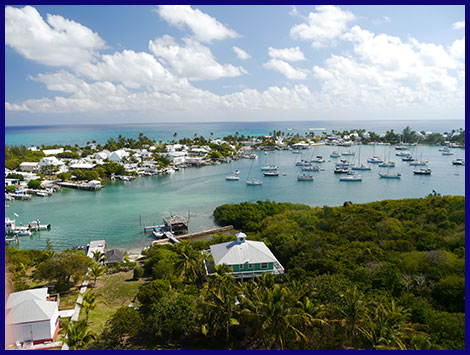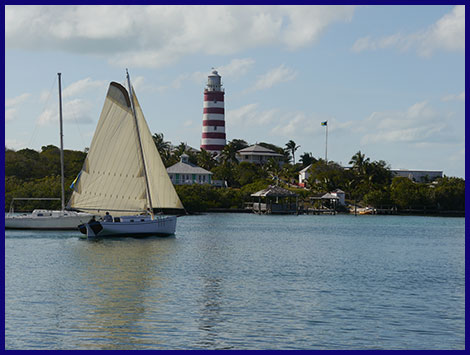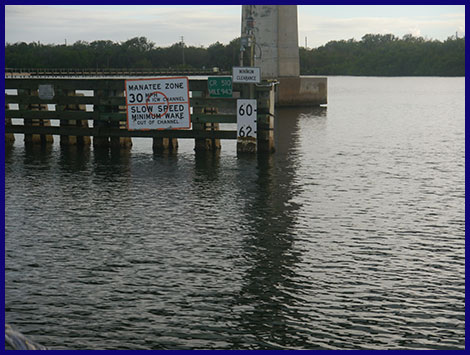
| The weather wasn't playing ball. We needed to get at least as far south as Palm Beach for our crossing to the Bahamas and the forecast showed no opportunity to sail south from St Augustine for the foreseeable future. Our only option would be to crawl down the Intra Coastal Waterway (ICW), but regular readers will remember that two years previously we had been forced to turn back at Wabasso (60 miles short of Palm Beach) because the water level was too high for Samarang to get under the bridge. However, over Christmas we'd been able to speak to a number of other sailors who had passed under the same bridge with much lower water levels. Over the next couple of weeks and during our trip to Cape Canaveral (the last place we could get out into the Atlantic before the dreaded bridge) we built a network of contacts who were heading south ahead of us and would be feeding back water levels and photos of the tide gauge as they passed under the bridge. And so it was, that on 12th January 2017 we crept towards the Wabasso bridge to find the tide gauge showing 64ft. Hurrah!!! Then, a few days on a mooring in Vero Beach rafted alongside Pemaquid, an Oyster 48, who has just replaced it's masthead light with a new low profile one - having crunched the original on the underside of our favourite bridge. We are not alone! Vero Beach is a sociable spot and we had time to get together with Jim & Wendy on Patty Jean and Rob & Janet on Shearwater, all heading for the Bahamas. On south to Palm Beach. First, to sit out the strongest cold front of the season, but second to have the opportunity to hook up with Theo and Rosemarie on Titaro. We had last met them in Guatemala when Titaro was a catamaran. The cat had long gone and been replaced with a Mainship motor cruiser, but the name remained the same. |
|
|
As soon as the weather broke we were off, there was a 48 hour window before the next front. Our next stop was (hopefully) to be Black Sound on Green Turtle Cay with good all round protection. Hopefully, because we could only scrape through the narrow shallow entrance (depth 1.4m) at high water springs. When we were here 2 years ago we would never have considered it, but 3 years of dragging our keel through the mud in the ICW had inured us to shallow water and Donny, the owner of the moorings there had agreed to meet us at the entrance and guide (and if necessary drag) us in. We touched a few times but made it to the mooring. And that was the start of a pattern. This season we spent our entire time in the Bahamas exploring places in the Abacos that we had considered too shallow to attempt when we were last here 2 years ago. A side effect of this was that because we could generally get in and out of these bays at High Water either side of spring tides and during daylight, we either had to limit our stays to a couple of days or stay for at least two weeks. And in the case of Black Sound, because of the need to also take advantage of a window to safely pass through the notorious Whale Cay cut, this visit would be the former. In our shallow water exploration, we also needed to know that if we did manage to wriggle our way into these anchorages at High Water (often a wriggle of a couple of miles) that there was space for us once we arrived - so that we didn't have to try and wriggle back out on what would by then have become a falling tide! For this we relied on feedback from friends on shallow draught boats who were acting as our recce parties. Hope Town was the classic example. Over a mile of shallow bank to negotiate before a complicated series of dog legs before arriving at the narrow entrance to the bay filled with mooring buoys but almost always fully occupied because it's such a popular spot - and only a couple of buoys big enough to take Samarang even when they do become available. But our recce party had been busy and we get a call from Jim on Patty Jean to say a boat is leaving. Their buoy isn't big enough for us, but Jim has negotiated a shuffle which will ultimately deliver us the buoy we need. All we have to do now is to get there without running aground! |
|
| Hope Town is gorgeous. It is easy to see why sailors come here every year and stay for the entire season. In spite of the annual influx of sailors and tourists somehow the small local population has managed to retain its identity in a way which we've rarely seen before. In part because we were trapped by the tides, in part because of the regular transition of cold fronts, but most of all because we really liked it, we ended up staying for nearly a month. | ||
 |
We fell into the rhythm of the weekly delivery boat, the weekly farmers market and the regular Happy Hours, we also pulled up and restuck down our badly lifting teak deck. We explored the island on foot and by dinghy. Climbed the only remaining operational clockwork lighthouse - which periodically stopped rotating when the lighthouse keeper fell asleep. We met the resident manatee who, legend has it, had developed an amorous attachment to a partially deflated dinghy and was now waiting forlornly for its return. (Manatees do have very poor eyesight.) We even managed to find a bar with a satellite package that included the rugby and who were quite happy to switch channels so we could watch the Six Nations even though we were the only people on the island who were interested. Finally though we had to leave. We needed to be back in Florida to begin preparing Samarang to be ready for the spring weather window for the crossing back to Europe. Time and tide (and weather windows) wait for no man. At the next high water springs we crept out of Hope Town for Marsh Harbour, for haircuts, dentists and provisioning. Having our track to follow made our departure slightly less nerve-wracking than our arrival, but only slightly! The trip north was to be close to a re-run in reverse of our trip to arrive here. A cycle of sheltering from the regular cold fronts, coordinating the next jump with the tides and finally positioning ourselves for the crossing back across the Gulf Stream for Florida. All of which would have been made slightly easier if the windlass hadn't failed catastrophically in the middle of all this. We were reduced to hauling anchor by hand with the help of blocks leading a rope back to the electric winch in the cockpit. A workable solution, but very slow if something bad happened and it certainly reduced our desire to anchor in deep water! |
 |
|
It is now March 16th and after much waiting and pouring over weather forecasts, we have a window, or at least we've convinced ourselves we have a window. It's shorter and less good than we would normally go for, but the time pressure is beginning to build and the joy of anchoring manually is beginning to wear a bit thin. The shortness of the window and the timing of the tides limits our options for a departure point and so our last ever anchorage in the Bahamas is Hawksbill Cay - shallow, rolly and badly protected. The following morning is grey, miserable and cold, but at least heaving the anchor warms me up and then we're off. We have 28 hrs to get across the Bahama Bank and the Gulf Stream to Florida. 24 hrs later we arrive at Fort Pierce, too early to stop so continue to Vero Beach for a few days to Clear in and prepare for the next steps and the next front. Preparation mainly consists of going up the mast and re-measuring its height above the water line - we're hoping it has shrunk. It hasn't but we do find that the lightning conductor is a lot longer than we thought. That explains why we scraped so many bridges! We remove it and take a series of measurements to be 100% sure of what we'll break at what clearance height. But with the lightning conductor gone and our tanks all completely full, so that we're as low as possible in the water, we are now quietly confident of our ability to clear all the bridges - with Lindy driving. No more slowing down and peering through binoculars to see the measurement on the tide gauge at the base of the bridge Dipping in and out of the ICW we arrive at the mouth of the St John's river at Jacksonville on the evening of Tuesday 28th March and dropped anchor in Sisters Creek so as to be able to ride the flood tide up river the following morning and arrive at the (very) shallow Ortega River Marina at High Water. Our car was still in the car park where we had left it and invaluable for our job list. This was to be our home for the next several weeks where we would repair, service and replace a seemingly endless list of things on the boat, whilst closing and selling a different list of things as we disentangled ourselves from life in the US - ultimately bidding farewell to our trusty Honda Accord, which had almost become a member of the family. |
||
